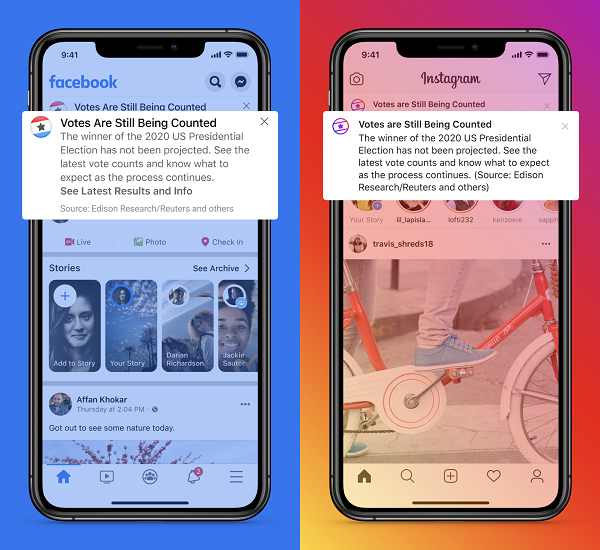SOCIAL
Blocked Hashtags, Violence Metrics, Bans – How Social Media Has Dealt with the US Election

For the last four years, the 2020 US Election has been projected as the ultimate test of social media networks and their capacity to respond to allegations of mass manipulation, foreign interference, fake news and more.
Facebook and Twitter, in particular, have worked to add in a range of new measures and tools to better protect the integrity of the critical vote, including new ad transparency measures, improved detection systems to stamp out ‘coordinated inauthentic behavior‘, updated response processes, etc.
So how have they done? Amidst the ongoing confusion around the results, as they continue to trickle in, how have the major social networks performed with respect to combating mass manipulation and counter-messaging through their apps?
Here’s a look at some of the key points of focus, and action, over the past week.
Accurate Updates
Facebook has been working to keep users updated on the latest, accurate polling information by adding prominent banners to feeds, in both Facebook and Instagram, which remind users that the votes are still being counted.

Yesterday, Facebook announced that it will soon share a new banner, once a winner of the election is projected by official sources, providing more context on the process.
Once Reuters and a majority of independent decision desks at major media outlets, including ABC, CBS, Fox, NBC, CNN and AP project a winner, we’ll update the notifications running across the top of Facebook and Instagram with the projected winner of the election. pic.twitter.com/5asIe2hZip
— Facebook Newsroom (@fbnewsroom) November 6, 2020
These official updates serve as a counter to the speculation online, and do seem to be having some impact in quelling angst around the result.
Though speculation of voter fraud, as provoked by the US President, is also having an impact – which Facebook is reportedly measuring, in real-time, via its own internal systems.
Predicting Violence
According to BuzzFeed News, Facebook has an internal measurement tool which it uses to predict the likelihood of potential real-world violence, based on rising discussion trends.

As explained by BuzzFeed:
“In a post to a group on Facebook’s internal message board, one employee alerted their colleagues to a nearly 45% increase in the metric, which assesses the potential for danger based on hashtags and search terms, over the last five days. The post notes that trends were previously rising “slowly,” but that recently “some conspiracy theory and general unhappiness posts/hashtags” were gaining popularity.”
Which is interesting, for several reasons.
For one, it shows that Facebook is aware of the influence it can have on real-world action, and that it understands that allowing certain trends to spread and grow can be dangerous. That means that Facebook is constantly measuring how far it can push things, and when it needs to slow trends up, in order to avoid them spilling over.
So for all it’s playing down of its potential to influence major incidents, Facebook knows that it does, and it allows certain controversial discussions to continue, uninhibited, until it deems that it needs to act.
That seems concerning, that Facebook is putting itself in a position to manage the balance between maximizing engagement and facilitating potential unrest.
The very existence of the metric shows that Facebook could likely do more to stop such movements before they gain traction.
It also shows that Facebook can’t play dumb on other topics, like QAnon or anti-vaxxers, as based on this data, it would be well aware of their potential for harm, well before they become problematic.
Many experts had called on Facebook to do more about QAnon for years, before Facebook finally took action. This metric, if it does exist, suggests that Facebook knew the risk all along, and only chose to act when it felt it was absolutely necessary. Which could be too late for any victims caught in the early crossfire. So who decides when the risk is too high, and should Facebook be in charge of making that call?
This will no doubt come under further investigation in the wake of the election.
Blocked Hashtags
Based on these insights, Facebook also took the additional step this week of blocking certain hashtags linked to the rising criticism of the vote-counting process.
Following US President Donald Trump’s unsubstantiated claims that the vote tallying process was ‘illegal’ and ‘rigged’, groups of Trump supporters gathered outside several vote counting centers across the US and began calling for poll workers inside to ‘stop the count’.
Again, with the threat of real-world violence rising, Facebook took action, blocking the hashtags #sharpiegate (in relation to the manual editing of vote slips), #stopthesteal and #riggedelection. TikTok also blocked these hashtags, while Twitter has continued to add warnings to all posts it detects which may contain election misinformation.
Indeed, incoming US Senator Marjorie Taylor Greene has seen a raft of her tweets hidden due to violations of Twitter’s election misinformation policy.

In addition to this, Facebook has also removed several groups which had been created on the back of questions around the election results, due to concerns that they could be used to organize violent protests in response.
Slowing Momentum
Facebook is also reportedly looking to add more friction to sharing of political posts in order to slow the momentum of conspiracy-fueling content.
As per The New York Times:
“Facebook plans to add more “friction” – such as an additional click or two – before people can share posts and other content. The company will also demote content on the News Feed if it contains election-related misinformation, making it less visible, and limit the distribution of election-related Facebook Live streams.”
Again, potentially based on its violence predictor, Facebook is looking to add more measures to reduce the spread of harmful misinformation, and material that could incite further tension within the community.
But a lot of content is still getting through – it’s not difficult to find various videos and posts on the platform which raise questions about the voting process.
It’s likely, of course, that Facebook can’t stop all of it, which is why adding more friction could be key to at least reducing dissent.
Removing Bannon
In another significant move, former Trump advisor Steve Bannon has been permanently banned from Twitter after calling for the beheadings of two top American public servants, in order to send a warning to others.
Bannon made the suggestion in a video, which has since also been removed from Facebook and YouTube as well.
Bannon was looking to equate modern-day politics to medieval times, saying:
“Second term kicks off with firing [FBI Director Christopher] Wray, firing [Dr. Anthony] Fauci. Now I actually want to go a step farther but I realize the President is a kind-hearted man and a good man. I’d actually like to go back to the old times of Tudor England. I’d put the heads on pikes, right, I’d put them at the two corners of the White House as a warning to federal bureaucrats – ‘you either get with the program or you’re gone – time to stop playing games.”
Bannon’s point was theoretical, not literal, but the concern here is that it’s entirely possible that not all of his listeners and/or supporters would derive the same meaning.
Bannon’s statement is another example of the importance of curbing violent rhetoric in public address, regardless of intention, as it can have significant consequences. Now, Bannon faces a ban, on several platforms, and could find it much harder to gain amplification for his future messaging as a result.
The Wash-Up
While the results of the election are not yet known, and may not be for some time, it does seem, at this stage, that the additional efforts and measures implemented by the major social platforms have been mostly effective in limiting the spread of misinformation, and quelling at least some of the angst around the results.
But we won’t know for a while yet. At present, there seems to be little discussion about foreign manipulation or similar, but it’s possible that it just hasn’t been detected. And while Facebook and Twitter are working quickly to add warning labels and limit distribution now, once the final results are announced, that could prove to be another key test.
There’ll still be a lot of assessment to come, and division in US society is still significant. But there are positive signs that the platforms themselves have done all they can, by most assessments.
SOCIAL
12 Proven Methods to Make Money Blogging in 2024

 This is a contributed article.
This is a contributed article.
The world of blogging continues to thrive in 2024, offering a compelling avenue for creative minds to share their knowledge, build an audience, and even turn their passion into profit. Whether you’re a seasoned blogger or just starting, there are numerous effective strategies to monetize your blog and achieve financial success. Here, we delve into 12 proven methods to make money blogging in 2024:
1. Embrace Niche Expertise:
Standing out in the vast blogosphere requires focus. Carving a niche allows you to cater to a specific audience with targeted content. This not only builds a loyal following but also positions you as an authority in your chosen field. Whether it’s gardening techniques, travel hacking tips, or the intricacies of cryptocurrency, delve deep into a subject you’re passionate and knowledgeable about. Targeted audiences are more receptive to monetization efforts, making them ideal for success.
2. Content is King (and Queen):
High-quality content remains the cornerstone of any successful blog. In 2024, readers crave informative, engaging, and well-written content that solves their problems, answers their questions, or entertains them. Invest time in crafting valuable blog posts, articles, or videos that resonate with your target audience.
- Focus on evergreen content: Create content that remains relevant for a long time, attracting consistent traffic and boosting your earning potential.
- Incorporate multimedia: Spice up your content with captivating images, infographics, or even videos to enhance reader engagement and improve SEO.
- Maintain consistency: Develop a regular publishing schedule to build anticipation and keep your audience coming back for more.
3. The Power of SEO:
Search Engine Optimization (SEO) ensures your blog ranks high in search engine results for relevant keywords. This increases organic traffic, the lifeblood of any monetization strategy.
- Keyword research: Use keyword research tools to identify terms your target audience searches for. Strategically incorporate these keywords into your content naturally.
- Technical SEO: Optimize your blog’s loading speed, mobile responsiveness, and overall technical aspects to improve search engine ranking.
- Backlink building: Encourage other websites to link back to your content, boosting your blog’s authority in the eyes of search engines.
4. Monetization Magic: Affiliate Marketing
Affiliate marketing allows you to earn commissions by promoting other companies’ products or services. When a reader clicks on your affiliate link and makes a purchase, you get a commission.
- Choose relevant affiliates: Promote products or services that align with your niche and resonate with your audience.
- Transparency is key: Disclose your affiliate relationships clearly to your readers and build trust.
- Integrate strategically: Don’t just bombard readers with links. Weave affiliate promotions naturally into your content, highlighting the value proposition.
5. Display Advertising: A Classic Approach
Display advertising involves placing banner ads, text ads, or other visual elements on your blog. When a reader clicks on an ad, you earn revenue.
- Choose reputable ad networks: Partner with established ad networks that offer competitive rates and relevant ads for your audience.
- Strategic ad placement: Place ads thoughtfully, avoiding an overwhelming experience for readers.
- Track your performance: Monitor ad clicks and conversions to measure the effectiveness of your ad placements and optimize for better results.
6. Offer Premium Content:
Providing exclusive, in-depth content behind a paywall can generate additional income. This could be premium blog posts, ebooks, online courses, or webinars.
- Deliver exceptional value: Ensure your premium content offers significant value that justifies the price tag.
- Multiple pricing options: Consider offering tiered subscription plans to cater to different audience needs and budgets.
- Promote effectively: Highlight the benefits of your premium content and encourage readers to subscribe.
7. Coaching and Consulting:
Leverage your expertise by offering coaching or consulting services related to your niche. Readers who find your content valuable may be interested in personalized guidance.
- Position yourself as an expert: Showcase your qualifications, experience, and client testimonials to build trust and establish your credibility.
- Offer free consultations: Provide a limited free consultation to potential clients, allowing them to experience your expertise firsthand.
- Develop clear packages: Outline different coaching or consulting packages with varying time commitments and pricing structures.
8. The Power of Community: Online Events and Webinars
Host online events or webinars related to your niche. These events offer valuable content while also providing an opportunity to promote other monetization avenues.
- Interactive and engaging: Structure your online events to be interactive with polls, Q&A sessions, or live chats. Click here to learn more about image marketing with Q&A sessions and live chats.
9. Embrace the Power of Email Marketing:
Building an email list allows you to foster stronger relationships with your audience and promote your content and offerings directly.
- Offer valuable incentives: Encourage readers to subscribe by offering exclusive content, discounts, or early access to new products.
- Segmentation is key: Segment your email list based on reader interests to send targeted campaigns that resonate more effectively.
- Regular communication: Maintain consistent communication with your subscribers through engaging newsletters or updates.
10. Sell Your Own Products:
Take your expertise to the next level by creating and selling your own products. This could be physical merchandise, digital downloads, or even printables related to your niche.
- Identify audience needs: Develop products that address the specific needs and desires of your target audience.
- High-quality offerings: Invest in creating high-quality products that offer exceptional value and user experience.
- Utilize multiple platforms: Sell your products through your blog, online marketplaces, or even social media platforms.
11. Sponsorships and Brand Collaborations:
Partner with brands or businesses relevant to your niche for sponsored content or collaborations. This can be a lucrative way to leverage your audience and generate income.
- Maintain editorial control: While working with sponsors, ensure you retain editorial control to maintain your blog’s authenticity and audience trust.
- Disclosures are essential: Clearly disclose sponsored content to readers, upholding transparency and ethical practices.
- Align with your niche: Partner with brands that complement your content and resonate with your audience.
12. Freelancing and Paid Writing Opportunities:
Your blog can serve as a springboard for freelance writing opportunities. Showcase your writing skills and expertise through your blog content, attracting potential clients.
- Target relevant publications: Identify online publications, websites, or magazines related to your niche and pitch your writing services.
- High-quality samples: Include high-quality blog posts from your site as writing samples when pitching to potential clients.
- Develop strong writing skills: Continuously hone your writing skills and stay updated on current trends in your niche to deliver exceptional work.
Conclusion:
Building a successful blog that generates income requires dedication, strategic planning, and high-quality content. In today’s digital age, there are numerous opportunities to make money online through blogging. By utilizing a combination of methods such as affiliate marketing, sponsored content, and selling digital products or services, you can leverage your blog’s potential and achieve financial success.
Remember, consistency in posting, engaging with your audience, and staying adaptable to trends are key to thriving in the ever-evolving blogosphere. Embrace new strategies, refine your approaches, and always keep your readers at the forefront of your content creation journey. With dedication and the right approach, your blog has the potential to become a valuable source of income and a platform for sharing your knowledge and passion with the world, making money online while doing what you love.
Image Credit: DepositPhotos
SOCIAL
Snapchat Explores New Messaging Retention Feature: A Game-Changer or Risky Move?

In a recent announcement, Snapchat revealed a groundbreaking update that challenges its traditional design ethos. The platform is experimenting with an option that allows users to defy the 24-hour auto-delete rule, a feature synonymous with Snapchat’s ephemeral messaging model.
The proposed change aims to introduce a “Never delete” option in messaging retention settings, aligning Snapchat more closely with conventional messaging apps. While this move may blur Snapchat’s distinctive selling point, Snap appears convinced of its necessity.
According to Snap, the decision stems from user feedback and a commitment to innovation based on user needs. The company aims to provide greater flexibility and control over conversations, catering to the preferences of its community.
Currently undergoing trials in select markets, the new feature empowers users to adjust retention settings on a conversation-by-conversation basis. Flexibility remains paramount, with participants able to modify settings within chats and receive in-chat notifications to ensure transparency.
Snapchat underscores that the default auto-delete feature will persist, reinforcing its design philosophy centered on ephemerality. However, with the app gaining traction as a primary messaging platform, the option offers users a means to preserve longer chat histories.
The update marks a pivotal moment for Snapchat, renowned for its disappearing message premise, especially popular among younger demographics. Retaining this focus has been pivotal to Snapchat’s identity, but the shift suggests a broader strategy aimed at diversifying its user base.
This strategy may appeal particularly to older demographics, potentially extending Snapchat’s relevance as users age. By emulating features of conventional messaging platforms, Snapchat seeks to enhance its appeal and broaden its reach.
Yet, the introduction of message retention poses questions about Snapchat’s uniqueness. While addressing user demands, the risk of diluting Snapchat’s distinctiveness looms large.
As Snapchat ventures into uncharted territory, the outcome of this experiment remains uncertain. Will message retention propel Snapchat to new heights, or will it compromise the platform’s uniqueness?
Only time will tell.
SOCIAL
Catering to specific audience boosts your business, says accountant turned coach

While it is tempting to try to appeal to a broad audience, the founder of alcohol-free coaching service Just the Tonic, Sandra Parker, believes the best thing you can do for your business is focus on your niche. Here’s how she did just that.
When running a business, reaching out to as many clients as possible can be tempting. But it also risks making your marketing “too generic,” warns Sandra Parker, the founder of Just The Tonic Coaching.
“From the very start of my business, I knew exactly who I could help and who I couldn’t,” Parker told My Biggest Lessons.
Parker struggled with alcohol dependence as a young professional. Today, her business targets high-achieving individuals who face challenges similar to those she had early in her career.
“I understand their frustrations, I understand their fears, and I understand their coping mechanisms and the stories they’re telling themselves,” Parker said. “Because of that, I’m able to market very effectively, to speak in a language that they understand, and am able to reach them.”Â
“I believe that it’s really important that you know exactly who your customer or your client is, and you target them, and you resist the temptation to make your marketing too generic to try and reach everyone,” she explained.
“If you speak specifically to your target clients, you will reach them, and I believe that’s the way that you’re going to be more successful.
Watch the video for more of Sandra Parker’s biggest lessons.
-

 PPC6 days ago
PPC6 days agoHow the TikTok Algorithm Works in 2024 (+9 Ways to Go Viral)
-

 SEO5 days ago
SEO5 days agoHow to Use Keywords for SEO: The Complete Beginner’s Guide
-

 MARKETING6 days ago
MARKETING6 days agoHow To Protect Your People and Brand
-

 MARKETING4 days ago
MARKETING4 days agoAdvertising on Hulu: Ad Formats, Examples & Tips
-

 MARKETING4 days ago
MARKETING4 days agoUpdates to data build service for better developer experiences
-

 MARKETING5 days ago
MARKETING5 days agoThe Ultimate Guide to Email Marketing
-

 SEO7 days ago
SEO7 days agoAutomate Multi-Site Reporting With Google Sheets And GSC API
-

 MARKETING22 hours ago
MARKETING22 hours ago18 Events and Conferences for Black Entrepreneurs in 2024



